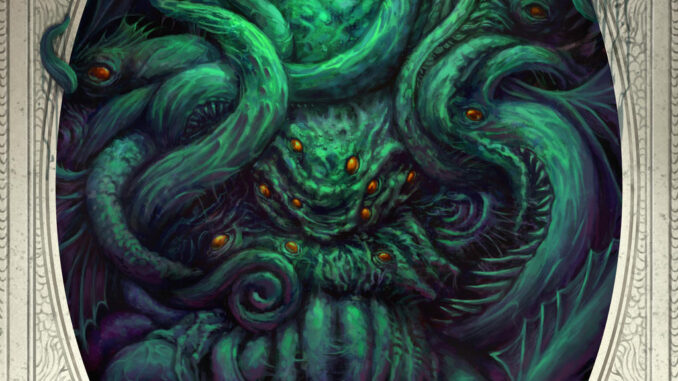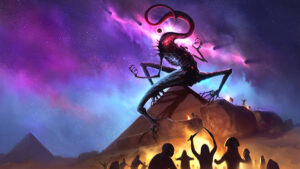
 I want to take a closer look at the amazing Call of Cthulhu campaign Masks of Nyarlathotep. There are games every avid roleplayer needs to experience, like Tomb of Horror, Murder on the Orient Express, and any game of Paranoia. These are rite of passage games. Memories from these sessions linger on.
I want to take a closer look at the amazing Call of Cthulhu campaign Masks of Nyarlathotep. There are games every avid roleplayer needs to experience, like Tomb of Horror, Murder on the Orient Express, and any game of Paranoia. These are rite of passage games. Memories from these sessions linger on.
Masks of Nyarlathotep is one such game. First printed in 1984, Masks set the tone for the quintessential Call of Cthulhu campaign: cults striving to bring down society and escalate their gods to power, traveling around the world and visiting exotic locations and working through a dizzying amount of clues to piece together the big picture.
Let’s take a second to go deeper into the sheer volume of clues and NPCs the investigators will be going through to make sense of this world-shattering adventure. Many Keepers proudly display walls covered in pictures and notes, with strings showing the relationships between NPCs and clues.
When I started running my own campaign I made it a requirement that every player take notes every session. Without doing this, there’s no way players would be able to remember a clue they stumbled upon three months ago that is suddenly going to pay off.
I gave up on the stance of letting the players struggle through their volumes of notes to connect the dots. Instead, I adopted the attitude that the characters the players were bringing to life are smarter and more invested in the mystery and would be able to make the connections, even if the players could not. So, I reminded players of things they should revisit when a new clue or contact popped up. I didn’t spell it out for them, but I saved them the frustration of talking to an NPC and not realizing they’d been told two countries ago and three months of game time earlier that she was a villain associated with a death cult.I preferred to say, “Her name reminds you of something Paul Fricker told you at the Egyptian Club in London.” The players would know to flip through their notes to the conversation with Paul and see if they can remember the obscure clue.
Masks of Nyarlathotep takes players around the world to fantastic locations, like a volcanic island in the South Pacific, a lost pyramid in Peru and a labyrinth beneath the Sphinx in Egypt. There’s plenty of immersive description in the boxed text of this 666-page beast of an adventure. To take things even further, Syrinscape has released a set of sound boards associated with each of the chapters of Masks, providing ambience sound, including period and locale music, urban and jungle sounds, plus the horrifying roars of the monsters who challenge the investigators. I wanted to use these tools, but I had two players in my game who find such things distracting from the game, so I didn’t use them.
Like Tomb of Horrors, Masks of Nyarlathotep is notorious for the high body count of investigators it piles up before the conclusion. Remember, in standard Call of Cthulhu it’s often wise to run from the monsters and live to investigate another day. Then, there’s Pulp Cthulhu, a mode where the PCs aren’t just investigators, they’re heroes who can go toe-to-toe with many of the Mythos monsters. I chose this mode, since I am a big fan of the pulp style.
That isn’t to say there weren’t hero deaths. Two went out in the first chapter, and everyone died in a TPK when the heroes got caught in a mine complex they had just rigged to explode. They were unaware that because they dined with creatures that live in the mine they were turning into that type of creature and would not ever be able to go out in the sun again. Nyarlathotep cornered the heroes at the mine entrance and battled them until the bomb went off.
Finally, there is an amazing tome of knowledge called the Masks of Nyarlathotep Companion, a 572-page tome written by Brett Baker and other Nyarlathotep Keepers who wanted to share their lore of how to run a successful Masks of Nyarlathotep campaign.
The book creates passages from the Mythos texts found during the duration of the campaign, so that characters can hear passages read to them. There are detailed write-ups about the local cults the investigators encounter in each country. It tells how they’re organized, what they believe, what demographics make up the organization, where they meet and what their rites are like. The book also tells what kind of encounters the investigators will have when they poke their noses too far into the cult’s workings. There are new subplots to add between adventures and plenty of tips how to digest the chapters to run successful sessions.
In the coming weeks, we will take detailed looks at each chapter of Masks. We’ll highlight the main sections and relate anecdotes of how things went when my own group took a crack at one of the most popular roleplaying campaigns of all time.
